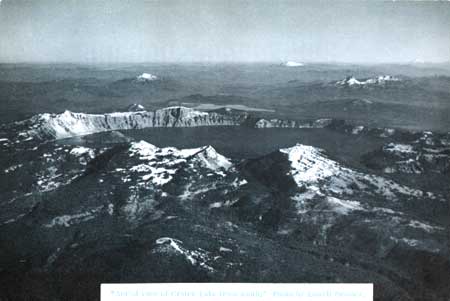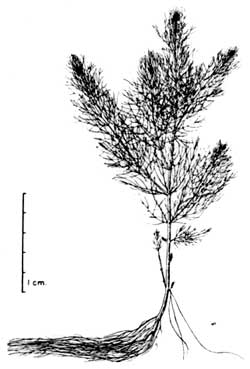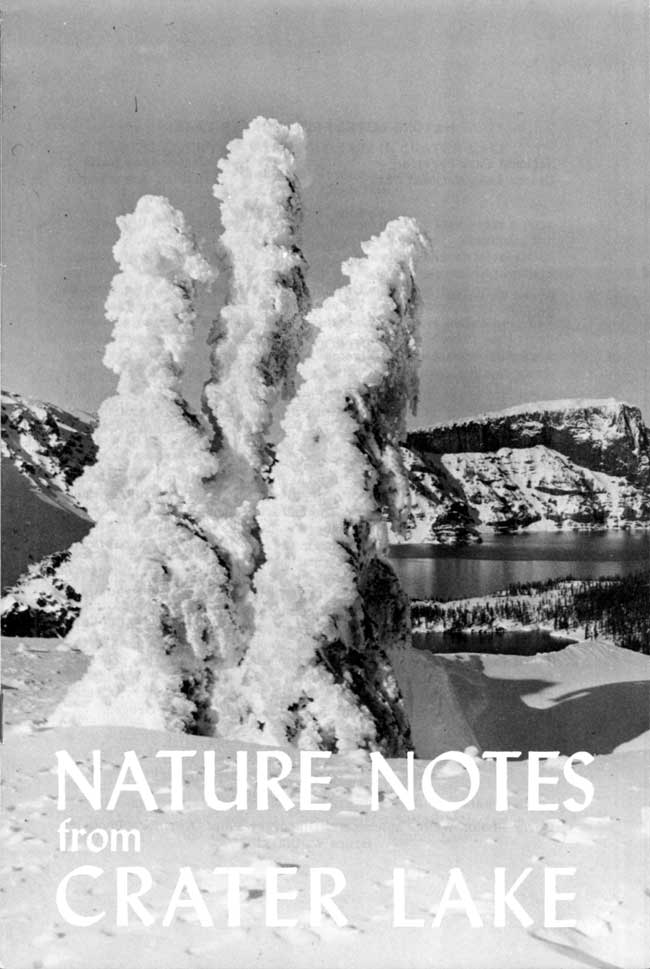Volume 22, 1956
All material courtesy of the National Park Service.These publications can also be found at http://npshistory.com/
Nature Notes is produced by the National Park Service. © 1956
Introduction
By Bruce W. Black, Editor
One of the objects of the Crater Lake Natural History Association is “to aid in the distribution of information on all subjects pertaining to the park.” It is in keeping with this aim that this 1956 number of Nature Notes from Crater Lake is presented. Reprinting of Nature Notes articles is encouraged; it is requested that acknowledgment be given both to the author and to this publication.
Each summer a dedicated National Park Service interpretive staff presents an excellent program of talks, nature trips, exhibits, and other informational services. The material found in the following articles is the result of staff members’ activities seldom brought to the attention of the visitor — the gathering of new information. Such efforts both document and give new information for talks.
The Crater Lake Natural History Association was founded in 1942 to promote and assist the interpretive program offered park visitors to further the investigation of subjects of popular interest and importance and to aid in the distribution of information on all subjects pertaining to the park. Toward this end it sponsors CRATER LAKE NATURE NOTES and operates a publications sales counter, the proceeds from which are used entirely to support this work. A list of items for sale may be obtained by writing to the Executive Secretary, Crater take Natural History Association, Box 97, Crater Lake, Oregon.

Aerial view of Crater Lake from south.
Photo by Lowell Sumner.
The Discovery of Myriophyllum in Crater Lake
By John R. Rowley and Joanne S. Rowley
University of Minnesota
Among the adventurously inclined, flower hunting may seem a poor substitute for arctic exploration or hunting elephants. Searching for aquatic flowering plants in Crater Lake, however, has an element of excitement which we believe greatly exceeds the general impression of such endeavor. Besides the exhilaration of just being on Crater Lake with its beautiful water encircled by the sheer cliffs of the caldera, the scarcity of flowering aquatics in the lake makes new discoveries especially rare and thrilling. Until recently only four species, occurring in small isolated colonies, were known (Rowles & Fairbanks 1954). Another intriguing factor is the great depth at which plants generally occurring in shallow water are found in this lake.
 Drawing made from the whorl-leaved milfoil collected in Crater Lake. |
During the 1956 summer, after searching much of the shore area of Crater Lake, we located a spot to the northwest of Wizard Island which seemed to have a colony of plants of some kind growing on the rocky bottom. Grappling for the suspected plants in 20 to 25 feet of water was a slow process due to a wind which greatly reduced visibility and made boat operation difficult. After several unsuccessful attempts we brought up a water-milfoil, a plant which had never been reported before in Crater Lake National Park.
There was no doubt that the new plant was water-milfoil and belonged to the genusMyriophyllum, for this genus is a distinctive assemblage of plants. Determination of the species was more difficult since keys to species of Myriophyllum depend in large part upon flowers, fruits and emergent leaves and we had only the submerged leaves and stem (Fig. 1). Our new plant could be any of the three major species in Oregon: American milfoil (Myriophyllum exalbescens Fernald), whorl-leaved milfoil (M. verticillatum L.), or western milfoil (M. hippurioides Nutt.).
The morphological features of the submerged leaves, such as the number of leaf whorls at each node and the number of leaflets per leaf, and the reported ecological distribution of these three species were compared with the Crater Lake plant by Richard McP. Brown, assistant park naturalist at Crater Lake National Park, Doctors J. W. Moore and T. Morley, Department of Botany, University of Minnesota, and ourselves. We have each independently concluded that Myriophyllum verticillatum is the most likely possibility, although a more positive identification must await the acquisition of emergent leaves and flowering material.
References
ROWLEY, JOHN R., and FAIRBANKS, C. WARREN, 1954. “Aquatic flowering plants of Crater Lake.” Nature Notes from Crater Lake 20:36-39.



